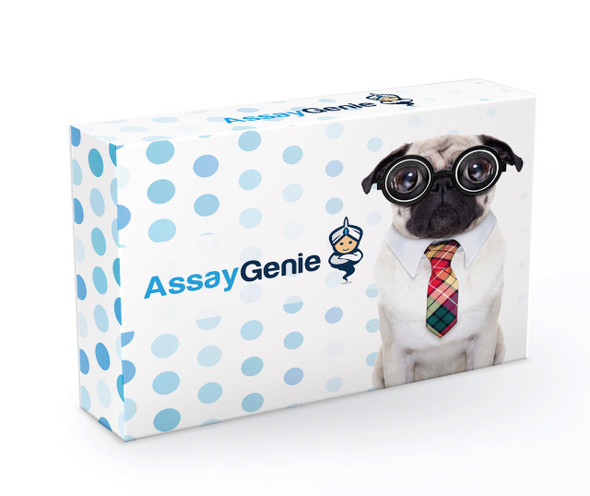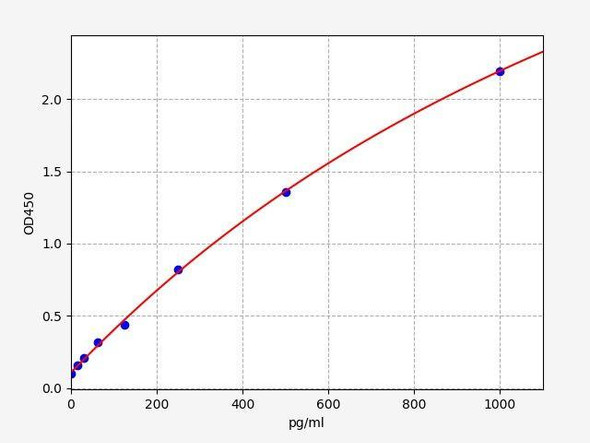Mouse EPO / Erythropoietin ELISA Kit (MOFI00033)
- SKU:
- MOFI00033
- Product Type:
- ELISA Kit
- Size:
- 96 Assays
- Uniprot:
- P07321
- Sensitivity:
- 9.375pg/ml
- Range:
- 15.625-1000pg/ml
- ELISA Type:
- Sandwich
- Synonyms:
- EPO, Erythropoietin, EP, MVCD2, Epoetin, Hematopoietin, Hemopoietin
- Reactivity:
- Mouse
- Research Area:
- Immunology
Description
Mouse EPO/Erythropoietin ELISA Kit
The Mouse EPO (Erythropoietin) ELISA Kit is specifically designed for the accurate measurement of erythropoietin levels in mouse serum, plasma, and cell culture supernatants. This kit offers high sensitivity and specificity, ensuring precise and reliable results for a variety of research applications.Erythropoietin is a key hormone that regulates the production of red blood cells in the body. It is essential for maintaining proper oxygen levels in the blood and plays a crucial role in conditions such as anemia, kidney disease, and cancer.
Studying erythropoietin levels can provide valuable insights into these conditions and aid in the development of potential treatments.Overall, the Mouse EPO ELISA Kit is a valuable tool for researchers studying the role of erythropoietin in health and disease, offering accurate and reproducible results to advance scientific understanding in this field.
| Product Name: | Mouse EPO / Erythropoietin ELISA Kit |
| Product Code: | MOFI00033 |
| Size: | 96 Assays |
| Alias: | EPO, Erythropoietin, EP, MVCD2, Epoetin, Hematopoietin, Hemopoietin |
| Detection Method: | Sandwich ELISA |
| Application: | This immunoassay kit allows for the in vitro quantitative determination of Mouse EPO concentrations in serum plasma and other biological fluids. |
| Sensitivity: | 9.375pg/ml |
| Range: | 15.625-1000pg/ml |
| Storage: | 4°C for 6 months |
| Note: | For Research Use Only |
| Recovery: | Matrices listed below were spiked with certain level of Mouse EPO and the recovery rates were calculated by comparing the measured value to the expected amount of Mouse EPO in samples. | ||||||||||||||||
| |||||||||||||||||
| Linearity: | The linearity of the kit was assayed by testing samples spiked with appropriate concentration of Mouse EPO and their serial dilutions. The results were demonstrated by the percentage of calculated concentration to the expected. | ||||||||||||||||
| |||||||||||||||||
| Intra Assay: | CV <8% | ||||||||||||||||
| Inter Assay: | CV <10% |
| Component | Quantity | Storage |
| ELISA Microplate (Dismountable) | 8×12 strips | 4°C for 6 months |
| Lyophilized Standard | 2 | 4°C/-20°C |
| Sample/Standard Dilution Buffer | 20ml | 4°C |
| Biotin-labeled Antibody(Concentrated) | 120ul | 4°C (Protect from light) |
| Antibody Dilution Buffer | 10ml | 4°C |
| HRP-Streptavidin Conjugate(SABC) | 120ul | 4°C (Protect from light) |
| SABC Dilution Buffer | 10ml | 4°C |
| TMB Substrate | 10ml | 4°C (Protect from light) |
| Stop Solution | 10ml | 4°C |
| Wash Buffer(25X) | 30ml | 4°C |
| Plate Sealer | 5 | - |
Other materials and equipment required:
- Microplate reader with 450 nm wavelength filter
- Multichannel Pipette, Pipette, microcentrifuge tubes and disposable pipette tips
- Incubator
- Deionized or distilled water
- Absorbent paper
- Buffer resevoir
| Uniprot | P07321 |
| UniProt Protein Function: | EPO: Erythropoietin is the principal hormone involved in the regulation of erythrocyte differentiation and the maintenance of a physiological level of circulating erythrocyte mass. Genetic variation in EPO is associated with susceptbility to microvascular complications of diabetes type 2 (MVCD2). These are pathological conditions that develop in numerous tissues and organs as a consequence of diabetes mellitus. They include diabetic retinopathy, diabetic nephropathy leading to end-stage renal disease, and diabetic neuropathy. Diabetic retinopathy remains the major cause of new-onset blindness among diabetic adults. It is characterized by vascular permeability and increased tissue ischemia and angiogenesis. Belongs to the EPO/TPO family. |
| UniProt Protein Details: | Protein type:Secreted; Secreted, signal peptide Cellular Component: extracellular space; cell surface; extracellular region Molecular Function:erythropoietin receptor binding; hormone activity; protein kinase activator activity Biological Process: hemoglobin biosynthetic process; heart morphogenesis; erythrocyte maturation; apoptosis; positive regulation of transcription, DNA-dependent; regulation of transcription from RNA polymerase II promoter; negative regulation of myeloid cell apoptosis; peptidyl-serine phosphorylation; positive regulation of tyrosine phosphorylation of Stat5 protein; positive regulation of protein kinase activity; positive regulation of cell proliferation; cardiac muscle morphogensis; response to hypoxia; erythrocyte differentiation; ventricular cardiac muscle morphogenesis; angiogenesis; positive regulation of Ras protein signal transduction; positive regulation of neuron differentiation; embryo implantation; positive regulation of DNA replication; negative regulation of apoptosis |
| NCBI Summary: | This gene encodes the glycoprotein hormone erythropoietin that regulates the production of red blood cells and biosynthesis of hemoglobin. The predominant expression of this gene shifts from the liver during fetal development to kidney in adults. A complete lack of the encoded protein causes embryonic lethal anemia in mice. The conditional inactivation of this gene in adult mice results in a chronic, normocytic and normochromic anemia. Transgenic mice expressing the human ortholog of this gene exhibit polycythemia. Alternative splicing results in multiple transcript variants encoding different isoforms. [provided by RefSeq, Aug 2015] |
| UniProt Code: | P07321 |
| NCBI GenInfo Identifier: | 119528 |
| NCBI Gene ID: | 13856 |
| NCBI Accession: | P07321.1 |
| UniProt Related Accession: | P07321 |
| Molecular Weight: | |
| NCBI Full Name: | Erythropoietin |
| NCBI Synonym Full Names: | erythropoietin |
| NCBI Official Symbol: | Epo |
| NCBI Protein Information: | erythropoietin |
| UniProt Protein Name: | Erythropoietin |
| Protein Family: | Erythropoietin |
| UniProt Gene Name: | Epo |
| UniProt Entry Name: | EPO_MOUSE |
*Note: Protocols are specific to each batch/lot. For the correct instructions please follow the protocol included in your kit.
| Step | Procedure |
| 1. | Set standard, test sample and control (zero) wells on the pre-coated plate respectively, and then, record their positions. It is recommended to measure each standard and sample in duplicate. Wash plate 2 times before adding standard, sample and control (zero) wells! |
| 2. | Aliquot 0.1ml standard solutions into the standard wells. |
| 3. | Add 0.1 ml of Sample / Standard dilution buffer into the control (zero) well. |
| 4. | Add 0.1 ml of properly diluted sample (Human serum, plasma, tissue homogenates and other biological fluids.) into test sample wells. |
| 5. | Seal the plate with a cover and incubate at 37 °C for 90 min. |
| 6. | Remove the cover and discard the plate content, clap the plate on the absorbent filter papers or other absorbent material. Do NOT let the wells completely dry at any time. Wash plate X2. |
| 7. | Add 0.1 ml of Biotin- detection antibody working solution into the above wells (standard, test sample & zero wells). Add the solution at the bottom of each well without touching the side wall. |
| 8. | Seal the plate with a cover and incubate at 37°C for 60 min. |
| 9. | Remove the cover, and wash plate 3 times with Wash buffer. Let wash buffer rest in wells for 1 min between each wash. |
| 10. | Add 0.1 ml of SABC working solution into each well, cover the plate and incubate at 37°C for 30 min. |
| 11. | Remove the cover and wash plate 5 times with Wash buffer, and each time let the wash buffer stay in the wells for 1-2 min. |
| 12. | Add 90 µL of TMB substrate into each well, cover the plate and incubate at 37°C in dark within 10-20 min. (Note: This incubation time is for reference use only, the optimal time should be determined by end user.) And the shades of blue can be seen in the first 3-4 wells (with most concentrated standard solutions), the other wells show no obvious color. |
| 13. | Add 50 µL of Stop solution into each well and mix thoroughly. The color changes into yellow immediately. |
| 14. | Read the O.D. absorbance at 450 nm in a microplate reader immediately after adding the stop solution. |
When carrying out an ELISA assay it is important to prepare your samples in order to achieve the best possible results. Below we have a list of procedures for the preparation of samples for different sample types.
| Sample Type | Protocol |
| Serum: | If using serum separator tubes, allow samples to clot for 30 minutes at room temperature. Centrifuge for 10 minutes at 1,000x g. Collect the serum fraction and assay promptly or aliquot and store the samples at -80°C. Avoid multiple freeze-thaw cycles. If serum separator tubes are not being used, allow samples to clot overnight at 2-8°C. Centrifuge for 10 minutes at 1,000x g. Remove serum and assay promptly or aliquot and store the samples at -80°C. Avoid multiple freeze-thaw cycles. |
| Plasma: | Collect plasma using EDTA or heparin as an anticoagulant. Centrifuge samples at 4°C for 15 mins at 1000 × g within 30 mins of collection. Collect the plasma fraction and assay promptly or aliquot and store the samples at -80°C. Avoid multiple freeze-thaw cycles. Note: Over haemolysed samples are not suitable for use with this kit. |
| Urine & Cerebrospinal Fluid: | Collect the urine (mid-stream) in a sterile container, centrifuge for 20 mins at 2000-3000 rpm. Remove supernatant and assay immediately. If any precipitation is detected, repeat the centrifugation step. A similar protocol can be used for cerebrospinal fluid. |
| Cell culture supernatant: | Collect the cell culture media by pipette, followed by centrifugation at 4°C for 20 mins at 1500 rpm. Collect the clear supernatant and assay immediately. |
| Cell lysates: | Solubilize cells in lysis buffer and allow to sit on ice for 30 minutes. Centrifuge tubes at 14,000 x g for 5 minutes to remove insoluble material. Aliquot the supernatant into a new tube and discard the remaining whole cell extract. Quantify total protein concentration using a total protein assay. Assay immediately or aliquot and store at ≤ -20°C. |
| Tissue homogenates: | The preparation of tissue homogenates will vary depending upon tissue type. Rinse tissue with 1X PBS to remove excess blood & homogenize in 20ml of 1X PBS (including protease inhibitors) and store overnight at ≤ -20°C. Two freeze-thaw cycles are required to break the cell membranes. To further disrupt the cell membranes you can sonicate the samples. Centrifuge homogenates for 5 mins at 5000xg. Remove the supernatant and assay immediately or aliquot and store at -20°C or -80°C. |
| Tissue lysates: | Rinse tissue with PBS, cut into 1-2 mm pieces, and homogenize with a tissue homogenizer in PBS. Add an equal volume of RIPA buffer containing protease inhibitors and lyse tissues at room temperature for 30 minutes with gentle agitation. Centrifuge to remove debris. Quantify total protein concentration using a total protein assay. Assay immediately or aliquot and store at ≤ -20 °C. |
| Breast Milk: | Collect milk samples and centrifuge at 10,000 x g for 60 min at 4°C. Aliquot the supernatant and assay. For long term use, store samples at -80°C. Minimize freeze/thaw cycles. |






